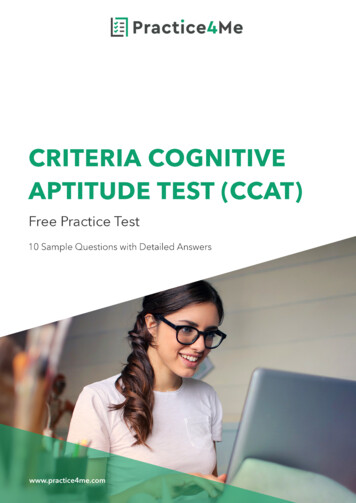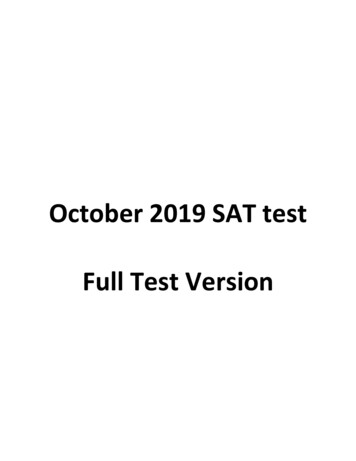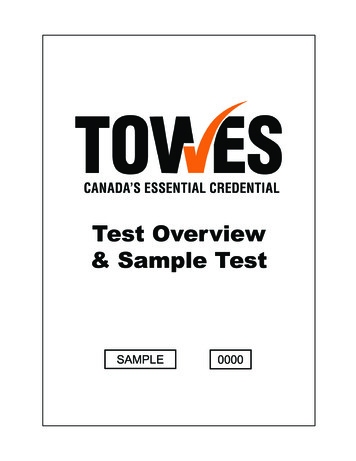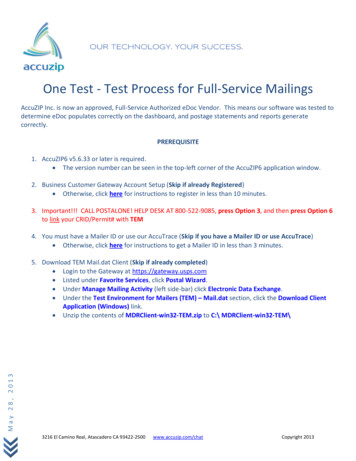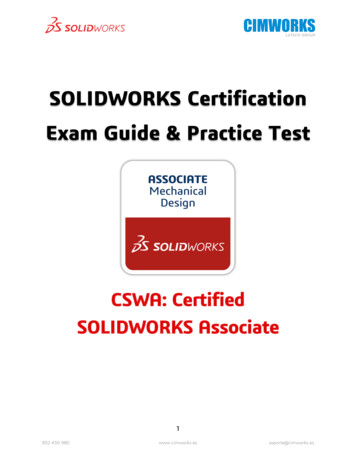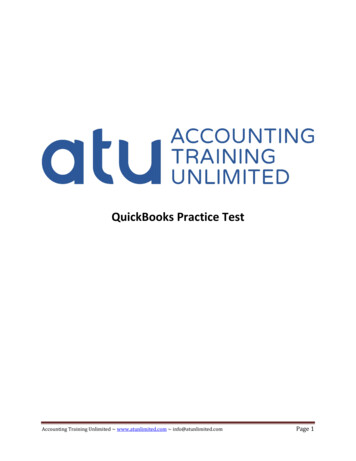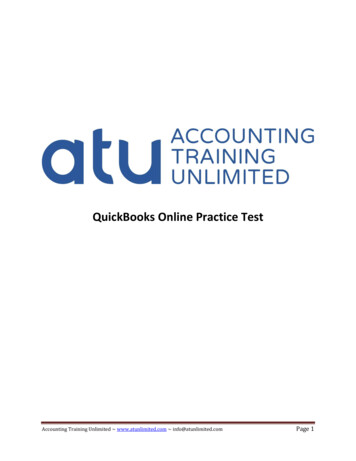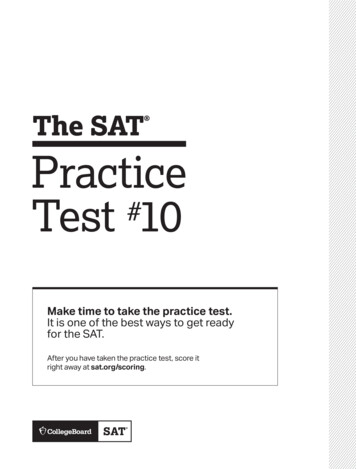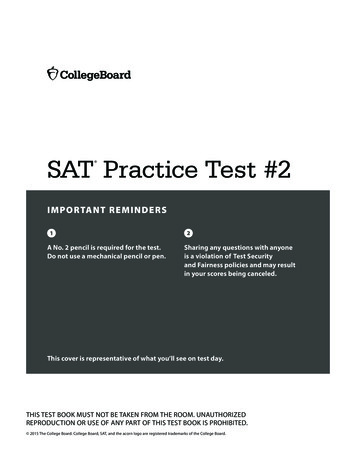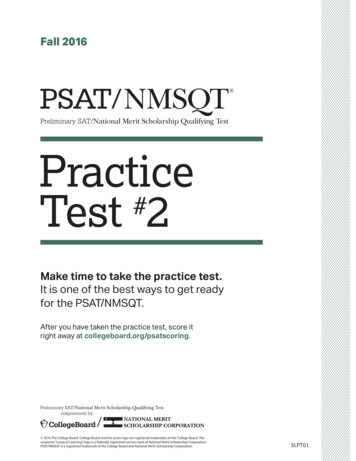
Transcription
Fall 2016Practice#Test 2Make time to take the practice test.It is one of the best ways to get readyfor the PSAT/NMSQT.After you have taken the practice test, score itright away at collegeboard.org/psatscoring. 2016 The College Board. College Board and the acorn logo are registered trademarks of the College Board. Thecorporate “Lamp of Learning” logo is a federally registered service mark of National Merit Scholarship Corporation.PSAT/NMSQT is a registered trademark of the College Board and National Merit Scholarship Corporation.5LPT01XXXXXX
Take the Practice TestTake the practice test on the following pagesto become familiar with the kinds of questions(reading, writing and language, and math) on thePSAT/NMSQT. The test you take in the fall willcontain the same four parts as this practice test:(1) reading questions, (2) writing and languagequestions, (3) math questions you cannot use acalculator on, and (4) math questions you can usea calculator on.Set aside about 2 hours and 45 minutes to take theentire test, and use the practice answer sheet onpages 3–6. Have your calculator available only forthe Math Test – Calculator. After the test, checkyour answers to see how you scored.Get Credit for All You Know Use a No. 2 pencil. Follow instructions for marking your answers,particularly for the Math student-producedresponse questions. Mark only one answer to each question. Make dark marks and fill circles completely. Erase completely if you change a response.STANDARD TIMINGReading Test:60 minutesWriting and Language Test: 35 minutesSCORINGEach correct answer:Wrong/blank answers:One pointNo points lostTest-Taking StrategiesTry these out when you take the practice test: Focus on easy questions first. For each correctanswer you receive one point, no matter how hardor easy the question is. Beware of careless errorson questions you know how to answer. You don’t have to get every question right.You can do well even though you answer somequestions incorrectly. Work steadily. Don’t waste time on a questionthat is hard for you. If you cannot answer it, markit in your test book and go on. Go back to it later ifthere is time. Use a watch to help with pacing. It’s okay to guess, especially if you can eliminatesome of the answers. You won’t lose any points ifyou guess incorrectly. Mark your answers in the correct row of circleson the answer sheet. Be especially careful if youskip questions. For math questions 14–17 and 28–31, first writeyour answer in the boxes above the circles, andthen grid your answer accurately and as completelyas the grid will accommodate. In the actual test,you must grid the correct answer in the circles toreceive credit. If the incorrect circles are marked, theanswer will be scored as incorrect, even if the rightanswer is given in the boxes. A common mistake ismarking two circles in the same column, so be sureto double-check your grids.Math Test – No Calculator:Math Test – Calculator:25 minutes45 minutesGUESSINGThere is no penalty for wrong answers, so itmakes sense to give the best answer you can toevery question, even if it is just your best guess.MARKING ANSWERSMake sure each mark is dark and completely fills the circle. If you erase, do so completely. You may usethe test book for scratch work, but for the actual test you will not receive credit for anything you write there.CHECKING ANSWERSWhen you take the test, you may check yourwork on a particular section if you finish itbefore time is called, but you may not turn toany other section.22016 PSAT/NMSQT Student Guide: Practice Test #2For information on how toscore your practice test, go to:collegeboard.org/psatscoring
PSAT/NMSQT PRACTICE ANSWER SHEETCOMPLETE MARKTEST NUMBERSECTION 1ENTER TESTNUMBER1For instance, for PracticeTest #1, fill in the circlefor 0 in the first columnand for 1 in the 7ADC37AD165B2615AA2514312entire circle darkly and completely. If you change your response, erase as completelyas possible. Incomplete marks or erasures may affect your score.D40123456789It is recommended that you use a No. 2 pencil. It is very important that you fill in theEXAMPLES OFINCOMPLETE MARKS47ABCD36Download the College Board SAT Practice app to instantly score this test.Learn more at collegeboard.org/psatscoring.2016 PSAT/NMSQT Student Guide: Practice Test #23
PSAT/NMSQT PRACTICE ANSWER SHEETIt is recommended that you use a No. 2 pencil. It is very important that you fill in theentire circle darkly and completely. If you change your response, erase as completelyas possible. Incomplete marks or erasures may affect your score.EXAMPLES OFINCOMPLETE MARKSCOMPLETE MARKSECTION CBCDBBBBCADBCBCDCADCCBCBCBCDBCDBCDBCDBCDAB2016 PSAT/NMSQT Student Guide: Practice Test A41ADD40ADC39ADB3834ADADA3733If you’re scoring with our mobile app we recommendthat you cut these pages out. The scoring does bestwith a flat 2AA29AD146D21ADC28AD135B20124A191139A101BCD
PSAT/NMSQT PRACTICE ANSWER SHEETIt is recommended that you use a No. 2 pencil. It is very important that you fill in theentire circle darkly and completely. If you change your response, erase as completelyas possible. Incomplete marks or erasures may affect your score.EXAMPLES OFINCOMPLETE MARKSCOMPLETE MARKSECTION D13ABCDABCD11A9BCD12Only answers that are gridded will be scored. You will not receive credit for anything written in the 788889999NO CALCULATORALLOWEDDid you know that you can print out these test sheetsfrom the web? Learn more at sat.org/scoring.2016 PSAT/NMSQT Student Guide: Practice Test #25
PSAT/NMSQT PRACTICE ANSWER SHEETIt is recommended that you use a No. 2 pencil. It is very important that you fill in theentire circle darkly and completely. If you change your response, erase as completelyas possible. Incomplete marks or erasures may affect your score.EXAMPLES OFINCOMPLETE MARKSCOMPLETE MARKSECTION 1824Only answers that are gridded will be scored. You will not receive credit for anything written in the 788889999If you’re using our mobile app keep in mind that bad lightingand even shadows cast over the answer sheet can affect yourscore. Be sure to scan this in a well-lit area for best results.62016 PSAT/NMSQT Student Guide: Practice Test #2CALCULATORALLOWED
11Reading Test6 0 M I N U T E S , 4 7 QU E ST IONSTurn to Section 1 of your answer sheet to answer the questions in this section.Each passage or pair of passages below is followed by a number of questions. After readingeach passage or pair, choose the best answer to each question based on what is stated orimplied in the passage or passages and in any accompanying graphics (such as a table orgraph).This passage is adapted from Mark Slouka, Brewster: A Novel. 2013 by Mark Slouka.Line510152025This was a time trial, he said—a one-mile timetrial, four laps—not a race. It was meant to give anidea of where we stood, no more.We’d gathered around the middle of the long sideof the track, just ten or twelve of us, including threeothers who seemed new like me, jogging back andforth in the wind, loosening up. The rest had walkedover to the other side of the field.Falvo took me aside. “Warmed up? How’re theshoes?”“Fine.” In the distance I could see kids walkingtoward the parking lot. The sun stabbed out fromunder the clouds, glancing off the windshields.He raised his voice over the wind. “All right, Iwant you all to stay contained, stay smooth. I don’twant to see anybody draining the well today—thatmeans you, Mr. McCann.” A tall, tough-looking kidwith red hair and a tight face smiled like a gunslinger.He turned to me. “I don’t want you doinganything stupid, Mosher. Some of these boys havebeen at it for a while. Don’t think about them, thinkabout yourself.”I shrugged.“Pace yourself. Let them do what they do. They’llbe about thirty yards ahead after the first lap. Don’tworry about them. Go out slow, feel your way, thenbring it home as best you can. OK?”“Sure,” I said.“Remember, it’s a time trial. Not a race.”Unauthorized copying or reuse of any part of this page is illegal.Questions 1-9 are based on the following passage.730354045505560There was no starting gun. We lined up in thegusty wind, Falvo standing in the soggy infield in hisdress shoes holding his clipboard like a small hightable against his chest with his left hand and hisstopwatch in his right and then he barked, “Runners. . . marks? Go!”They didn’t run, they flowed—the kid in theheadband, the red-headed kid, and two or threeothers in particular—with a quiet, aggressive,sustained power that looked like nothing but feltlike murder and I was with them and then halfwaythrough the third turn they were moving awaysmooth as water and I could hear them talkingamong themselves, and I was slowing, burning,leaning back like there was a rope around my neck.“Too fast, Mosher, too fast,” I heard Falvo yelling,and his ax-sharp face came out of nowhere lookingalmost frantic and then it was gone and there wasjust the sound of my breathing and the crunch of mysneakers slapping the dirt. The group, still in a tightcluster, wasn’t all that far ahead of me.By the end of the second lap I heard someone faraway yelling “Stop, Mosher, that’s enough,” and thenat some point someone else calling “Comingthrough—inside,” and they passed me like a singlemass, all business now, and I remember staggeringafter them, gasping, drowning, my chest, my legs, mythroat filling with lead and looking up through a fogof pain just in time to see the kid with the headband,halfway down the backstretch, accelerating into asustained, powerful sprint.CO NTI N U E
170758085901Based on the passage, which character would mostlikely agree with the idea that, when tryingsomething new, it is best not to push one’s limits?A) FalvoB) McCannC) MosherD) The person who said “Let him go”Unauthorized copying or reuse of any part of this page is illegal.65I don’t know why. I can’t explain it. By the end ofthe third lap I was barely moving, clawing at the air,oblivious to everything except the dirt unfoldingendlessly in front of me. “Let him go,” I heardsomebody say. They’d all finished by then, recovered,and now stood watching as I staggered past them likesomething shot. “C’mon . . . ” I heard someone startto call out uneasily, and then, “What’s his name?”A small crowd, I found out later, sensing somethinggoing on, had gathered by the fence to the parkinglot. The last of the newcomers had passed melong ago.I remember seeing him appear in front of me likeI was coming up from underwater and trying toswerve but I was barely standing and I walked rightinto him and he caught me as I fell, his one good armaround my back, saying over and over, “All right,easy now, easy, you’re done, keep walking, walk itoff,” like he was gentling a horse. I threw up on theinfield grass.“What we have here,” he was saying, “is a failureto communicate. Stay within yourself, I said.Don't drain the well, I said.”“What did I get?” I couldn’t seem to hold my headup, or open my eyes—the pain kept coming in waves.“What?”“Time. What time did I get?”He laughed—that bitter Falvo laugh—ha!—likehe’d just been vindicated. “He wants to know whathe got,” he said, like there was somebody with us.“You want to know what you got? I’ll tell youwhat you got: proof you could beat yourselfsenseless—something I very much doubt youneeded.”182Which choice provides the best evidence for theanswer to the previous question?A) Lines 14-17 (“All right . . . McCann”)B) Lines 19-22 (“He turned . . . yourself”)C) Lines 55-60 (“I remember . . . sprint”)D) Lines 76-79 (“he caught . . . horse”)3In the context of Falvo’s instructions to the runners,the main purpose of lines 24-27 (“Pace . . . OK”) is toA) provide useful general information to the group.B) emphasize and elaborate on advice given earlier.C) introduce a philosophy applicable to sportsand life.D) reveal Falvo’s underlying motivation.CO NTI N U E
1In the context of the passage, “I shrugged” (line 23)and “‘Sure,’ I said” (line 28) mainly serve to show thenarrator’sA) shyness.B) dismissiveness.C) dishonesty.D) hostility.5Based on the passage, how did the experiencedrunners respond to Falvo’s advice?A) They enthusiastically embraced it.B) They acted like they hadn’t heard it.C) They generally accepted it.D) They only pretended to take it seriously.Unauthorized copying or reuse of any part of this page is illegal.4196What does the narrator say about his motivation forperforming as he did in the time trial?A) That he was determined to keep up with theother runnersB) That he wanted to prove something to himselfC) That he wished to improve on his previous timeD) That he was unable to provide a reason for hisbehavior7Which choice provides the best evidence for theanswer to the previous question?A) Lines 36-39 (“They didn’t . . . power”)B) Line 61 (“I don’t . . . explain it”)C) Lines 73-76 (“I remember . . . into him”)D) Lines 91-94 (“I’ll . . . needed”)CO NTI N U E
1Based on the passage, when Falvo says, “Don’t drainthe well” (line 83), he most probably meansA) don’t use up all of your energy.B) don’t get sick.C) don’t try to outdo one another.D) don’t quit before you’re finished.Unauthorized copying or reuse of any part of this page is illegal.81109As used in line 89, “vindicated” most nearly meansA) avenged.B) set free.C) defended against.D) proven right.CO NTI N U E
1This passage is adapted from Moisés Naím, The End ofPower: From Boardrooms to Battlefields and Churches toStates, Why Being in Charge Isn’t What It Used to Be. 2013 byMoisés Naím.Line510152025303540The number of democracies in the world today isunprecedented. And remarkably, even the remainingautocratic countries are less authoritarian thanbefore, with electoral systems gaining strength andpeople empowered by new forms of contestation thatrepressive rulers are poorly geared to suppress. Localcrises and setbacks are real, but the global trend isstrong: power continues to flow away from autocratsand become more fleeting and dispersed.The data confirm this transformation: 1977 wasthe high-water mark of authoritarian rule, with90 authoritarian countries. A respected source,Freedom House, assessed whether countries areelectoral democracies, based on whether they holdelections that are regular, timely, open, and fair, evenif certain other civic and political freedoms may belacking. In 2011 it counted 117 of 193 surveyedcountries as electoral democracies. Compare thatwith 1989, when only 69 of 167 countries made thegrade. Put another way, the proportion ofdemocracies in the world increased by just over halfin only two decades.What caused this global transformation?Obviously local factors were at work, but scholarSamuel Huntington noted some big forces as well.Poor economic management by many authoritariangovernments eroded their popular standing. A risingmiddle class demanded better public services, greaterparticipation, and eventually more political freedom.Western governments and activists encourageddissent and held out rewards for reform, such asmembership in NATO or the EU or access to fundsfrom international financial institutions. A newlyactivist Catholic Church under Pope John Paul IIempowered opposition in Poland, El Salvador, andthe Philippines. Above all, success begat success, aprocess accelerated by the new reach and speed ofmass media. As news of democratic triumphs spreadfrom country to country, greater access to media byincreasingly literate populations encouragedemulation. In today’s digital culture, the force of thatfactor has exploded.Unauthorized copying or reuse of any part of this page is illegal.Questions 10-18 are based on the followingpassage and supplementary material.11145505560657075There have been exceptions, of course—not justcountries where democracy has yet to spread butothers where it has experienced reversals.Larry Diamond, a leading scholar in this field, callsthe stalling in recent years in countries like Russia,Venezuela, or Bangladesh a “democratic recession.”Yet against this is mounting evidence that publicattitudes have shifted. In Latin America, for example,despite persistent poverty and inequality, andconstant corruption scandals, opinion polls showgreater confidence in civilian government than in themilitary.Even autocracies are less autocratic today.According to one study of the world’s democraticelectoral systems, Brunei may be the only countrywhere “electoral politics has failed to put down anymeaningful roots at all.” With far fewer repressiveregimes in the world, one might have expected theholdouts to be places where freedom and politicalcompetition are increasingly suppressed. But in factthe opposite is true. How? Elections are central todemocracy but they are not the only indicator ofpolitical openness. Freedom of the press, civilliberties, checks and balances that limit the power ofany single institution (including that of the head ofstate), and other measures convey a sense of agovernment’s grip on society. And the data show thaton average, even as the number of authoritarianregimes has gone down, the democracy scores ofcountries that remain politically closed have gone up.The sharpest improvement occurred in the early1990s, suggesting that the same forces that pushed somany countries into the democratic column at thattime had profound liberalizing effects in theremaining nondemocratic countries as well.CO NTI N U E
11Number of countries80604020050 55 60 65 70 75 80 85 90 95 00 05 1019 19 19 19 19 19 19 19 19 19 20 20 20democraciesautocraciesAdapted from Monty G. Marshall, Keith Jaggers, and Ted RobertGurr. "Political Regime Characteristics and Transitions, 1800–2010,"Polity IV Project.Unauthorized copying or reuse of any part of this page is illegal.100Proliferation of Democracies andthe Decline of Autocracies: 1950–20111210Over the course of the passage, the main focusshifts fromA) a discussion of the increase in democracies andpolitical openness to an analysis of the causes ofthe increase.B) a claim that electoral democracies have becomeless politically open to a discussion of the effectsof the decreased openness.C) an explanation of one set of data about a trendtoward political openness to an explanation of aconflicting set of data.D) a positive portrayal of democracy to a strongdenunciation of autocracy.11As used in line 20, “put” most nearly meansA) imposed.B) placed.C) incited.D) stated.CO NTI N U E
1As used in line 31, “held out” most nearly meansA) resisted.B) awaited.C) avoided.D) offered.13Which choice best supports the claim that increasedpolitical openness is a widespread, global trend?A) Line 23 (“What . . . transformation”)B) Lines 26-27 (“Poor . . . standing”)C) Lines 41-42 (“In today’s . . . exploded”)D) Lines 56-59 (“According . . . all”)Unauthorized copying or reuse of any part of this page is illegal.1211314The passage characterizes the state of politicalopenness in autocratic regimes as unexpected in thatA) instead of becoming more oppressive,autocracies are becoming more democratic.B) data indicate that the regimes are becoming lessdemocratic, while opinion polls indicate that thepublic believes regimes are becoming moredemocratic.C) despite the recent, well-publicized trend towarddemocratization, there have been many localsetbacks.D) in a reversal of the trend over the last decade,political openness in autocracies is on thedecline.15Which choice provides the best evidence for theanswer to the previous question?A) Lines 18-22 (“Compare . . . decades”)B) Lines 46-50 (“Larry . . . shifted”)C) Lines 59-63 (“With far . . . true”)D) Lines 73-77 (“The sharpest . . . well”)CO NTI N U E
1Which of the following is cited in the passage as anindicator of political openness?A) A strong head of stateB) Freedom of the pressC) Confidence in the militaryD) Presence of a digital culture17According to the graph, the number of autocracies in1975 was less than the number ofA) democracies in 1950.B) democracies in 1995.C) autocracies in 2011.D) democracies in 2011.Unauthorized copying or reuse of any part of this page is illegal.1611418According to the graph, the number of democracieswas roughly equal to the number of autocracies inwhich of the following ranges?A) 1975–1980B) 1985–1990C) 1995–2000D) 2005–2010CO NTI N U E
1This passage is adapted from Bettina Boxall, “YellowstoneWolves Boost Berry Diet for Grizzlies, Study Says.” 2013 byLos Angeles Times.Line5101520253035In another example of how the return of a toppredator can have far-reaching ecological effects,researchers have found that the reintroduction of thegray wolf to Yellowstone National Park has boostedan important food source for the threatened grizzlybear. A study published in the Journal of AnimalEcology is essentially a tale of who eats what.When wolves were reintroduced to the park in1995 after a 70-year absence, they preyed on elkherds that browsed trees and shrubs.The elkpopulation, which had exploded without the wolves,dropped. The over-browsed plants began to rebound,including berry-producing shrubs that providenutritious summer meals for grizzlies when they arefattening up for hibernation.“The grizzly bear uses some of the same plantsthat the prey of the wolf uses,” said William Ripple,an Oregon State University professor of forestecosystems and lead author of the study. “Thereintroduction of one top predator is potentiallyaffecting another top predator through this foodweb.”Ripple and his fellow researchers at OSU andWashington State University compared thefrequency of fruit found in grizzly bear scat (animalfecal droppings) to elk numbers before and after wolfintroduction. Over a 19-year period, they found thatthe average proportion of fruit in grizzly scat rosesignificantly after wolves returned to Yellowstoneand the elk population fell. The scientists examinedand rejected other possible explanations for thesmaller, pre-wolf proportion of fruit in grizzlydiets—such as climate influences or the operation ofopen-pit garbage dumps that served as bear messhalls before the last one was closed in 1970.Unauthorized copying or reuse of any part of this page is illegal.Questions 19-28 are based on the followingpassage and supplementary material.115404550556065Previous research by Ripple and colleagues hasdemonstrated other ways in which the gray wolf’sreturn has had a cascading effect in the GreaterYellowstone Ecosystem, the wildest in the lower48 states. Ripple’s work was the first to show thataspens declined after wolves were eliminated fromthe park in the 1920s. When wolves returned anddrove down the elk numbers, scientists saw aresurgence of aspen, cottonwood, and willows insome parts of the park that has led to an increase inbeavers.“We’re in the early stages of this ecosystemrecovery. This is what we call passive restoration,”Ripple said. “We put the wolf back in and then we letnature take its course.” In the case of the grizzly, thepaper’s authors said increasing berry productioncould help make up for the loss of another bear foodthreatened by climate change, whitebark pine nuts.The Yellowstone region’s whitebark pines havebeen dying en masse, the victim of beetle killspromoted by milder winters. Wildlife biologistsworry the diminishing nut crop could hurt grizzlysurvival.Ripple cautioned that it will take time forberry-producing shrubs to regrow.“It may not be apanacea or a big silver bullet as a food item for thegrizzlies.”The wolf-bear connection in Yellowstone offers abroader lesson, Ripple said. “We should be lookingmuch farther and much more holistically at largemammal or predator management,” he suggested.“There could be far reaching effects that we have notconsidered in the past. And they can be veryimportant.”CO NTI N U E
1Year Winter elk count Wolf numbers Wolf/elk .1220048,33510612.72*Poor counting conditions; count is likely a substantial underestimate.**Elk count not available in 1996 and 1997.Adapted from Patrick J. White and R. A. Garrott, “Northern YellowstoneElk after Wolf Restoration.” 2005 by John Wiley & Sons, Inc.19The main purpose of the passage is toA) discuss an ecological phenomenon.B) analyze a scientific experiment.C) resolve an environmental debate.D) draw attention to a historic discovery.Unauthorized copying or reuse of any part of this page is illegal.Annual Counts of Northern Yellowstone Elk and Wolvesand the Ratio of Wolves per 1,000 Elk, 1986–200411620According to the passage, what was a direct result ofthe drop in the elk population at YellowstoneNational Park?A) An investigation of the grizzly bear populationB) A decrease in the number of aspen treesC) An increase in fruit-bearing plantsD) A surge in the wolf population21Which choice provides the best evidence for theanswer to the previous question?A) Lines 6-7 (“A study . . . what”)B) Lines 12-15 (“The over-browsed . . .hibernation”)C) Lines 42-46 (“When . . . beavers”)D) Lines 49-50 (“We put . . . course”)22According to the passage, one potential challenge tothe survival of the grizzly bear population inYellowstone National Park is a shortage ofA) elk.B) beetles.C) cottonwood trees.D) whitebark pine trees.CO NTI N U E
1Which choice provides the best evidence for theanswer to the previous question?A) Lines 27-30 (“Over . . . fell”)B) Lines 50-53 (“In the . . . nuts”)C) Lines 59-60 (“Ripple . . . regrow”)D) Lines 60-62 (“It may . . . grizzlies”)24As used in line 10, “browsed” most nearly meansA) inspected.B) skimmed.C) destroyed.D) grazed.25Which choice most closely captures the meaning ofthe figurative “big silver bullet” referred to in line 61?A) Unexpected outcomeB) Tempting choiceC) Definitive solutionD) Dangerous event26The main purpose of the final paragraph of thepassage is toA) advise the reader of some potential limitations ofRipple’s conclusions about the nutritional needsof the grizzly bear.B) extend the implications of the relationshipbetween wolves and grizzlies in a particularenvironment to other animals and contexts.C) describe a certain experiment that Ripple will beundertaking in the future to corroborate hisfindings.D) suggest the potential ramifications ofreintroducing another species into an alreadyfragile ecosystem.Unauthorized c
reading questions, (2) writing and language questions, (3) math questions you cannot use a calculator on, and (4) math questions you can use a calculator on. Set aside about 2 hours and 45 minutes to take the entire test, and use the practice answer sheet on pages 3–6. Have your calculator availa


